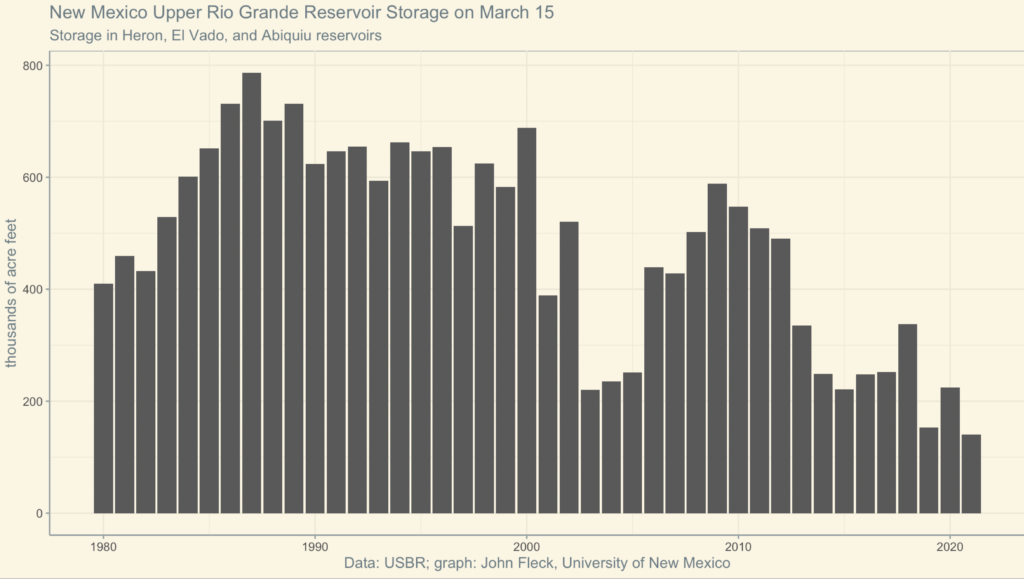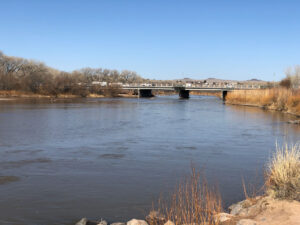
Total storage on New Mexico’s Upper Rio Grande reservoirs right now is the lowest it’s been at this point in the spring in over four decades of records
No sooner did my spring break begin a week ago (quite literally within a couple of hours of the end of my last class before break) than I got sick. This has led to much laying around, and resting, which I think was the point?
I’m finally on the mend, and a friend got me out of the house yesterday morning for a walk down by the river. Which was nice, except I have the sort of friends who have the latest Rio Grande gossip. Like about how we could see the river go dry by June, stuff like that.
Sigh.

Rio Grande at Albuquerque’s Central Avenue Bridge, March 19, 2021
To be honest, the river looks pretty good right now. There were a few buds to be seen, but mostly the river’s still wearing its winter colors, the quiet tans and browns that I’ve always thought were one of its best looks. With the gauge at the Central Avenue Bridge reading a bit less than 600 cubic feet per second, it was enough water to barely fill the channel from bank to bank, which as you can see from the picture also is a nice look. It’s only 25th percentile flow for this time of year, but not awful.
The awful is the thing we expect to come next.
The March 1 forecast called for 54 percent of the long term mean flow in the river into New Mexico’s “Middle Rio Grande Valley” – the part of the river where I live, the “Albuquerque reach”. That’s the mid-point, the one-in-ten best chance (90th percentile) is 93 percent of average, the one-in-ten worst (10th percentile) is 26 percent.
That’s bad, but the situation is made far worse by the graph at the top of the page. Mid-March total storage in the three upstream reservoirs was just 140,300 acre feet, which is just 29 percent of average and, more importantly, the worst in the dataset that I have access to, which goes back to 1980.
We’ve limped by in recent years by draining storage, keeping the river wet for the cultural and environmental benefits that provides, and keeping the irrigation ditches wet as well. That’s not going to be possible this year. That’s why my gossipy friend, who is connected, pointed to the possibility of river drying by June.
A note on data sources and methods: The data comes from the USBR Upper Colorado Region’s historical datasets, to be found here. I grabbed the data for Heron, Abiquiu, and El Vado reservoirs, summing up total storage for March 15 every year for which we had data on all three, which goes back to 1980. There’s probably longer datasets available somewhere, but I’m just an unpaid blogger with a few spare hours on a spring weekend, so you get what you pay for, eh?

summed up, seine out as many ES as possible, hope wolf Creek pass gets buried, News on the San Juan isn’t encouraging as they’re looking at a storage short situation. Some increased upper Basin storage on the San Juan might be beneficial?
Hey John, nice post. A couple thoughts: 1) the flow at the central gage is higher than it would be otherwise because MRGCD has delayed starting its irrigation season until April 1. That includes the 6 MRG Pueblos agreeing to delay. It’s to try to repay Elephant Butte for the use of Compact retained debit water in the middle valley last summer which led to a reduced delivery to Elephant Butte and a greater Accrued Debit for NM.
2) Because of Accrued Debit, the low predicated runoff, and the storage constraints of Articles VI and VII, the only storage of Rio Grande water that will occur above Elephant Butte this Spring is to protect delivery of water the the prior and paramount lands of the 6 MRG Pueblo’s.
3) This set up of conditions hasn’t occurred in over 40 years. I has occurred before a number of times during the 1950’s thru 1970’s extended drought. I doubt there are any water managers working today that worked thru that tough period.